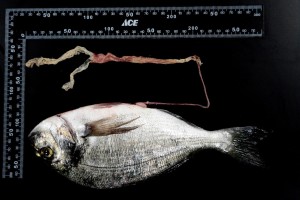
Plastic Found Inside An European Seabream During Myxozoa (Enteromyxum leei) Analysis
During a routine myxozoa analysis (Enteromyxum leei), which involves examining fish intestines for parasitic organisms, a significant discovery was made: an almost 22-centimeter piece of plastic was found inside the intestine of a seabream. This finding is alarming and underscores the growing issue of plastic pollution in our oceans. Marine animals, like seabream, often ingest plastic mistaking it for food, leading to severe health problems such as blockages, toxicity, and internal injuries. In this particular case, the large plastic piece caused a significant blockage in the fish's digestive tract, making it difficult for the seabream to digest food properly and absorb necessary nutrients. This blockage can lead to malnutrition, weakness, and ultimately, the death of the fish if the plastic is not expelled. The sharp edges of the plastic could also cause internal injuries, leading to infections and further complications. The presence of such a large piece of plastic indicates the widespread nature of this issue, affecting marine life from tiny plankton to large whales. This case study highlights the urgent need to reduce plastic use, recycle properly, participate in clean-up events, and educate others about the dangers of plastic pollution. Taking these steps can help protect marine life and ensure the health of our oceans for future generations.
